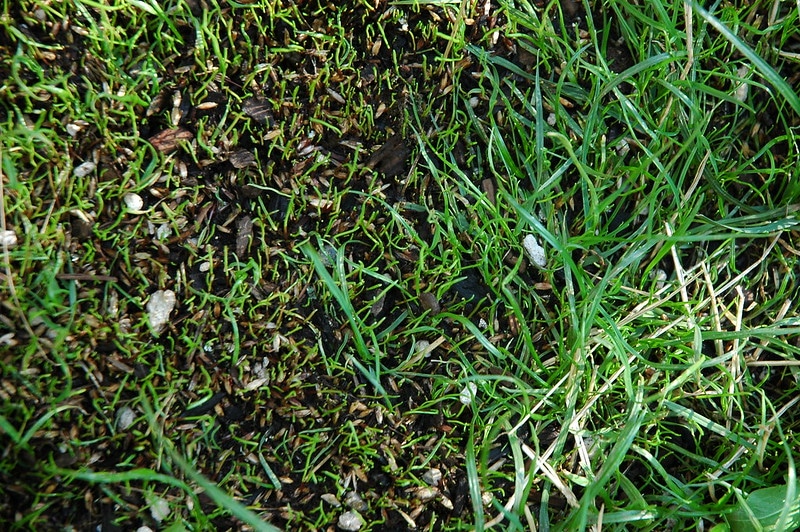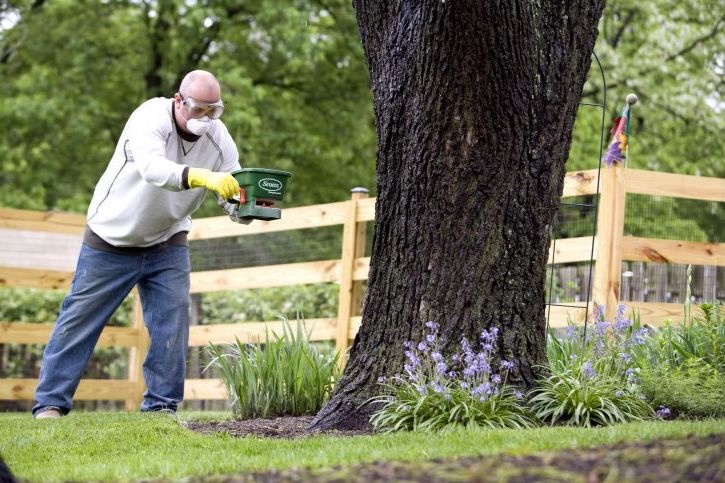Overseeding 101
| Step | Description | Tips |
|---|---|---|
| Choose the Right Seed | Select a grass type suited to your climate and lawn’s needs. | Research grass types for shade tolerance, drought resistance, etc. |
| Test Soil | Check soil pH and nutrient levels. | Soil testing kits are available at garden centers. Adjust soil based on test results. |
| Mow and Rake | Mow lawn to a low height and rake to remove debris. | Mowing short allows seeds to reach the soil more easily. |
| Aerate the Lawn | Create holes in the soil to allow air, water, and nutrients to penetrate. | Aerating helps seeds germinate and grow. |
| Spread the Seed | Evenly distribute grass seed over your lawn. | Use a spreader for even coverage. Follow seed rate recommendations. |
| Fertilize | Apply a starter fertilizer. | Choose a fertilizer high in phosphorus to promote root growth. |
| Water Regularly | Keep the soil consistently moist. | Water lightly and frequently to prevent washing away seeds. |
| Maintain New Grass | Mow and care for new grass properly. | Wait until new grass is tall enough before the first mow. |
The Benefits of Overseeding a Lawn
When overseeding a lawn, you’ll plant new grass seeds directly into the existing grass. There’s no need to turn over the turf for planting to be successful.
Overseeding is the best way to fill bare spots in your lawn; it will help improve the lawn’s quality, making it thicker and healthier.
Overseeding can also reduce the likelihood that weeds will grow and give the lawn a more uniform appearance. Most people decide to overseed their lawn as it has thinned, and they want to stop weeds from growing.
Things to Consider Before Overseeding Your Lawn
Overseeding your lawn correctly can be a challenge; follow these simple steps to overseed your lawn correctly. The first thing you need to think about before overseeding your yard is the time of year.
Many people believe that they should overseed their lawn in the spring as this is when the grass starts to grow, and they begin thinking about lawn maintenance.
However, spring isn’t the best time. If the grass hasn’t taken root by the summer and you live in a hot climate the sun can cause new grasses to wilt and die, or turn yellow.
You’ll end up wasting both your time and money if you overseed at the wrong time of year. To work out the best time to overseed, you’ll also need to consider which type of grass is growing in your garden. Grasses are known as either cool season grasses or warm season grasses.
Cool-season grasses
Cool season grasses should be overseeded in the late summer or early fall. August to October is the best time to overseeding this type of grass, as your lawn will already be thriving.
The soil will still be warm from the summer months, and days will still be sunny. This encourages the grass seeds to germinate while the cool air during fall will encourage the grass to grow.
Warm-season grasses
Warm season grasses should be overseeded in the late fall or early winter. If you’re growing tougher grasses, you can plant the seed about forty-five days before the first frost.
If you live in a warmer climate, plant at least six weeks before the weather starts to get cold. October and November are great months for overseeding this type of grass.
Preparation for Overseeding a Lawn
Before overseeding, you’ll need to prepare your lawn. To do this, you can cut your grass using a lawnmower to a shorter length than you usually would.
This will help the seed to get in contact with the soil and will give you greater success when overseeding. It will also mean that you can leave your lawn longer before it needs to be mowed again, which will give the grass seeds a chance to grow.
You can then rake up all the grass clippings and loosen the turf with your rake. Also, remove any debris from your lawn. Raking your lawn with a metal rake will help loosen the soil, which will help the seeds to grow.
Choosing a Grass Seed
You’ll need to choose the correct grass seed for your climate and one that will grow around your existing grass. Choose a good quality grass seed that will grow year-round.
It’s also a good idea to think about how much sunlight is needed for the seeds to grow. Don’t buy a grass seed that needs to be planted in a sunny location if you plan to plant it in a shaded area.
The best grass seeds for overseeding spread via Rhizomes. This type of grass will send both shoots and roots out horizontally and will quickly fill in the bare spots on your lawn. You’ll end up with a very thick and dense lawn.
When to Overseed For Each Climate Zone
| Climate Zone | Best Time to Overseed | Notes |
|---|---|---|
| Cool Season (e.g., Northeast, Midwest) | Early Fall (September to early October) | Cool nights, warm days, and dew in the morning create ideal conditions. |
| Transition Zone (e.g., Mid-Atlantic, Central US) | Fall (September to October) or Spring (March to April) | Avoid hot summer months; spring and fall provide moderate temperatures. |
| Warm Season (e.g., South, Southeast) | Late Spring to Early Summer (May to June) | Warm-season grasses thrive in higher temperatures. |
| Arid/Desert (e.g., Southwest) | Fall (September to October) | Cooler temperatures and lower evaporation rates are beneficial. |
| Pacific Northwest | Early Fall (September) | Ample moisture and mild temperatures support seed germination. |
| Mediterranean (e.g., Coastal California) | Fall (October to November) | Cooler temperatures and upcoming rainy season aid in growth. |
| Tropical (e.g., Florida, Hawaii) | Late Spring to Early Summer (May to June) | Consistent warmth and moisture are ideal for tropical grasses. |
The Overseeding Process
After you’ve chosen the correct seed and prepared your lawn, it’s time for overseeding. Follow these simple steps to overseed your lawn effectively.
Spread the Seeds
It’s a good idea to read the grass seed packets label before spreading the seeds as this will tell you the rate of overseeding. The best way to spread your grass seeds is by using a lawn spreader. These are available from gardening or hardware stores.
Spread the seeds on a calm day so that the wind doesn’t blow them away. Aim to evenly distribute the seeds across your lawn, paying close attention to any patchy areas.
Caring for Your Lawn After Overseeding
Once you’ve distributed your grass seed, you’ll need to provide fertilizer to encourage the seeds to grow. Fertilizer provides the roots with essential nutrients that will help them to germinate and grow healthy.
There are many different kinds of fertilizers on the market, such as Milorganite so you’ll need to consider your budget, the amount of fertilizer required, and the impact on the environment when choosing a fertilizer.
Fertilizers are either made using natural, organic formula or chemicals. All-natural fertilizer is generally considered to be the best option for fertilizing new grass seeds. Choose a fertilizer that contains phosphorous as this helps to encourage rapid root growth.
Top Tip: If you have bald patches on your lawn, you may like to cover them with a thin layer of compost after sprinkling the seeds.
Watering the grass seed
Water will help your grass seeds grow, and new seeds require plenty of water for the first week after planting. Use a watering can that creates a light sprinkle and keep your soil moist by watering twice daily for the first week.
In the second week, give your lawn more water than in the first to encourage growth. After two weeks, you can water as needed. This will depend on the climate where you live.
If you live somewhere hot, you’ll need to continue watering your lawn but can do so with a sprinkler. This will help to prevent your grass from wilting and will create a healthy lawn.
Avoid These Common Mistakes When Overseeding a Lawn
Overseeding may seem pretty straightforward, but homeowners make a few mistakes when sewing grass seeds on their lawn.
The wrong type of seed
Many people make the mistake of purchasing an incorrect grass seed. It would help if you chose a grass seed that’s compatible with your lawn and will grow in your climate.
Please don’t make the mistake of buying cheaper seeds as this means you’re getting older seeds that are past their best and may not grow as well.
Seeding rates
Pay attention to the seeding rates, which will be printed on the grass seeds box. You’ll have more success if you use the correct amount of seeds.
Timing
It may be tempting to overseed your grass at the wrong time of year, but this is not a wise move. Late summer, fall, and early winter is the best time to overseed, but it all depends on what type of grass you’re planting.
Weed treatments
Don’t use weed treatments on areas that have been recently overseeded as this is likely to kill your new grass. Here’s when to treat weeds before overseeding.
Conclusion
If you’re overseeding for the first time, it can feel a bit daunting. However, as long as you follow the above process, you’re likely to be successful. Overseeding will allow you to create a beautiful, healthy lawn, and you may even be the envy of your neighbors.
Once the young grass shoots have been growing for two weeks, you can carry on with your normal lawn maintenance. Your new seeds should be sprouted and rooted within two weeks, and you’ll have a lovely lawn.
When to Overseed Bermuda in Georgia: Keeping Your Georgia Lawn Healthy and Dense


